A sleeping mat is a vital component of our kit list alongside a good sleeping bag if you want a comfortable night on the hills with a tent. A sleeping mat can be the difference between a decent night’s sleep and a very bad one. The best sleeping mats won’t just be comfortable to lie on but they’ll also keep you warm and that’s why insulation performance is perhaps the most important aspect of a sleeping mat to consider.
Sitting on a rock on the summit to enjoy the view on a chilly day, one can feel the warmth draining away – now imagine that same effect along the length of one’s entire body, all night. And our sleeping bag is only half the story. As insulating as it may be, our body weight flattens out the insulation below us and minimises its effectiveness. The right sleeping mat will prevent downwards heat loss from your body and this should make your night safer and more comfortable when using a sleeping pad.
A smaller pack size and weight are welcome when carrying something to a high camp, and it’s worth experimenting to get the best fit. sleeping pads are usually sold as solid, rolled-up cylinders, but you can flatten them and fold them into your pack. Careful pitching is important. It’s easy to tear and deflate mats by catching a sharp rock under the tent, or accidentally rolling over onto crampons or stove parts in your sleep. Make sure you can repair a puncture, either with the manufacturer’s kit or your own.
Practising inflation and deflation is also worthwhile – wrestling with new kit in a cramped tent in the rain is no fun at all!
How we tested them
Kirsty Pallas
Kirsty is just over five feet tall (but not quite 5’1”!), so having a short or petite mat works well. She sleeps cool when camping, so will look for a higher R-value for more insulation from the ground. These mats have been tested while camping in the Scottish Highlands through a cool and wet spring and summer. All weights are from Kirsty’s own scales, and packed sizes are measured by Kirsty.
David Lintern
David tested his mats over winter and spring from glen to mountain summit camps and a few inbetween, all in Highland Scotland. He sometimes used the mats together and sometimes apart and always in different shelters, to help gauge form and function. Weights are from his own scales and includes stuff sacks.
The best sleeping mats 2025: our expert picks
This article will provide you with knowledge on some of the best sleeping mats around to help you make a judgement on your next purchase. We’ve tested all types of mats from mummy mats, which are more suited to one-person tents, to wide rectangular mats which offer an improved comfort. This guide covers sleeping mats from brands such as Rab, Alpkit, Big Agnes and many more.
Therm-a-Rest NeoAir Xlite NXT
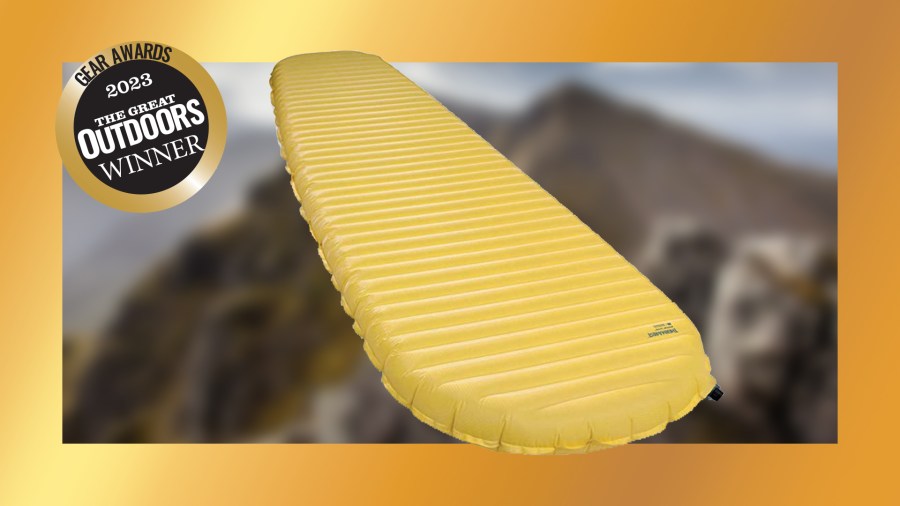
TGO Gear Award Winner
Performance and low weight make it an excellent choice for high camps and multi-day trips, but it does come at a premium price.- Weight
- Packability
- Warmth
- Price
| Quick specs | |
|---|---|
| RRP: $209.95 | £210 Weight: 378g Rating: 4/5 Type: air Materials: 30D rip HT nylon, polyurethane Dimensions: 183x51cm (R) Thickness: 7cm Sizes: Short (330g, 168x51cm) + Regular + Regular Wide (440g, 183x64cm) + Regular Long (470g, 196x64cm) Rating: R-value 4.5 |
This mat gained the top spot in The Great Outdoors Awards for 2023, with the jury recognising it for its Thermacapture lining, a heat reflecting layer within the mat that ups its R-value to an impressive 4.5. The previous version of this mat had a reflective lining, but this was rustly and made for a noisy sleep. With this new version, Therm-a-rest have got rid of that issue and upped the insulating value without adding any extra weight,
The ThermaCapture material within the previous mat would rustle whenever you moved. That problem doesn’t exist any more. It offers an extremely comfortable, warm and a quiet night’s sleep now.
The NeoAir is a compact, rounded mummy shape and a small pack size of 20x13cm. It is easy to inflate with the pump sack that comes with it and has a repair kit with cleaning wipes and stick-on patches. Performance and low weight make it an excellent choice for high camps and multi-day trips, but it does come at a premium price.
Read more: Therm-a-Rest NeoAir Xlite NXT review
Available from: thermarest.com
RAB Ionosphere 5
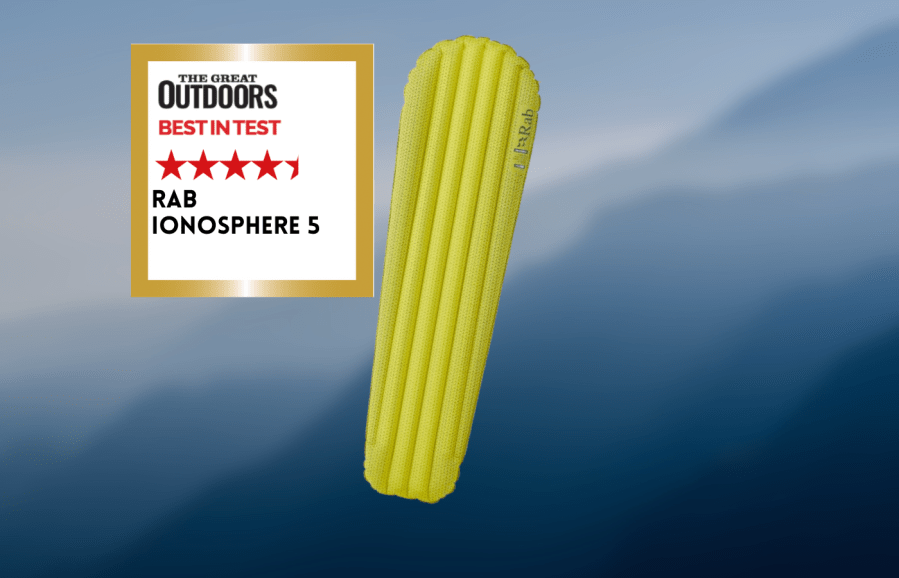
David Lintern Best in Test
The Ionosphere 5 hits a sweet spot of comfort, warmth, packability and price and addresses some environment concerns with it’s use of materials.- Warmth
- Pack Size
- None
| Quick specs | |
|---|---|
| Price: £170 Weight: 633g (regular) Type: air mat Materials: 20D Recycled Polyester outer fabric with internal TPU Coating and fluorocarbon free DWR, and Stratus™ R 100% recycled polyester insulation 160gsm with TILT. Dimensions: 183x51cm (regular) Thickness: 8cm Rating: 4.8 Sizes: Regular, Long wide Women’s version: unisex rab.equipment |
The Ionosphere 5 sleeping mat is a comfortable, warm, and lightweight option that is suitable for both tall and restless sleepers. It features baffles along the length and oversized tubes on the outer edge to prevent rolling off during the night. The mat is internally insulated with synthetic fill and reflective film, and materials are recycled. The R value of 4.8 is realistic, and no cold spots were experienced during cold test camps. The inflation bag fits securely onto the valve, and it only takes five bags of air to inflate. The Ionosphere 5 packs down into a soft pouch, making it easy to use. The 20D shell is tough enough for long-term camp use, and a repair kit is included. The mat addresses some environmental concerns with its materials and the 20D shell is tough enough for long-term camp use. Overall, the Ionosphere 5 sleeping mat is a great choice for those seeking a comfortable, warm, and lightweight option.
Read David Lintern’s full Rab Ionosphere 5 Review
Mountain Equipment, Mirrostat 7.0
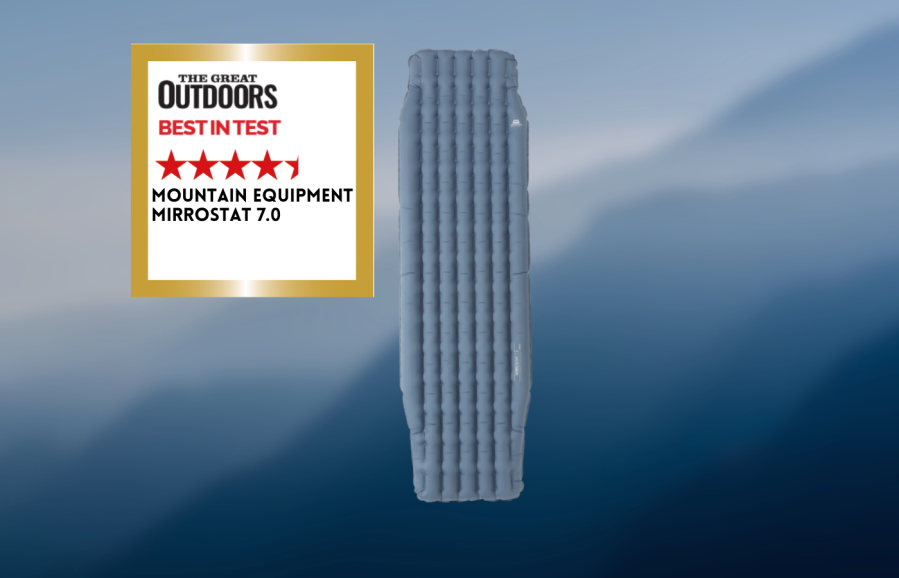
Kirsty Pallas’ Best in Test
This is a fantastic mat if you’re looking for something warm and light, and willing to pay a slightly higher price for it.- Weight
- Warmth
- Price
- Pump sack shape
| Quick specs | |
|---|---|
| Price: £200 Weight: 535g Type: Air Materials: Recycled 20D plain weave polyester, TPU lamination, Mylar reflective film Dimensions: 190cm x 51cm for regular Thickness: 9cm Rating: 4.5 R-value Sizes: Regular and long Men’s version: Unisex URL: https://www.mountain-equipment.co.uk |
The Mirrostat 7.0 is Mountain Equipment’s top-end sleeping mat for warmth and weight, offering impressive insulation due to its mylar reflective film. It is not a women’s mat or a petite size, making it suitable for winter use but still lightweight for cold weather. The mat features vertical baffles with slight spaces between each, which saves weight but remains warm and comfortable. The two outside baffles are larger to keep you in the middle, allowing you to sleep without feeling restricted. The mat is rectangular with slightly shaved corners to save weight without restricting sleeping.
The pumpsack, part of the stuff sack, folds out when pulled out, but it is long and narrow, making it difficult to manage in a one-person tent. The valve is multifunctional and includes a repair kit. The recycled polyester is the lowest denier at 20D, shaved off some weight but may be slightly less durable than other mats. The Mirrostat 7.0’s packed size is 28cmx10cm, but it can be squeezed down if packed next to something else. When deflated and rolled up, it is small and light compared to other mats. This mat is a fantastic choice for those looking for warmth and light at a slightly higher price.
Read Kirsty’s full Mountain Equipment, Mirrostat 7.0 Review
Thermarest Z Lite SOL
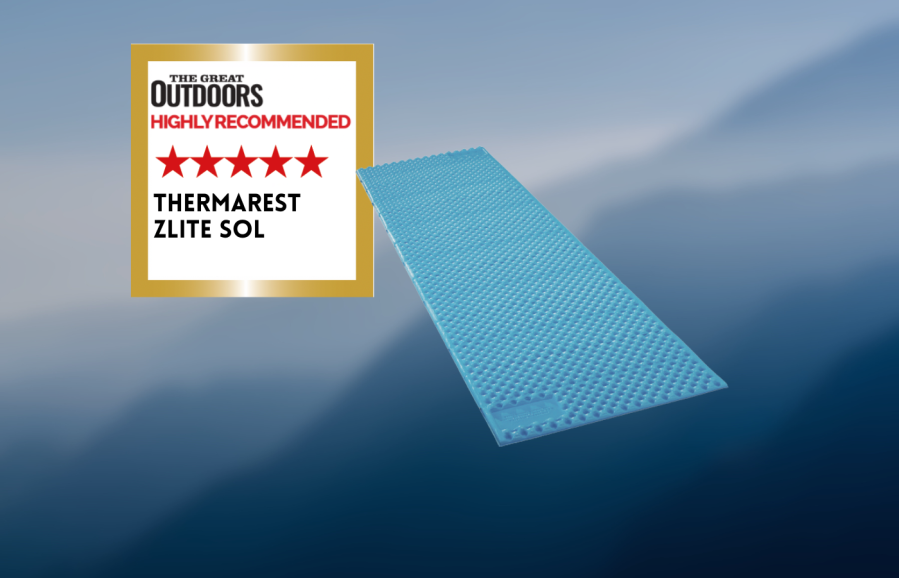
David Lintern Highly Recommends
My original lasted over a decade and still works, although it has lost a little volume – that’s hundreds of nights out.- Durability
- Warmth for weight
- Value for money
- None
| Quick specs | |
|---|---|
| Price: £60 Weight: 390cm (regular) Type: Foam, non-inflating Materials: Polyethylene foam Dimensions: 51cm x 183cm (size Regular) Thickness: 2cm Rating: 2.0 Sizes: Regular, small Women’s version: unisex www.thermarest.com |
The Z lite SOL sleeping mat is a popular outdoor gear due to its simplicity, indestructibility, and ability to provide protection from the ground for minimal weight. Its slivered surface adds 0.3 to its R value without weight penalty. Both Z lites have an eggbox-like construction, providing more ‘cush’ than flat-surfaced closed cell foam mats. While not as thick or comfortable as air mats, it is thick enough for summer use without feeling cold at night. The foam absorbs very little water and can be easily stacked with an air mat for colder weather and puncture protection. The foam absorbs very little water, making it ideal for family camps. The original Z lite SOL lasted over a decade and still works, although it has lost some volume. It is a practical and practical choice for backpacking trips, especially for families with kids who are tough on kit. The original offers better value for money than other camping items.
Read David Lintern’s full Thermarest Z Lite SOL Review
Thermarest, Women’s ProLite Plus
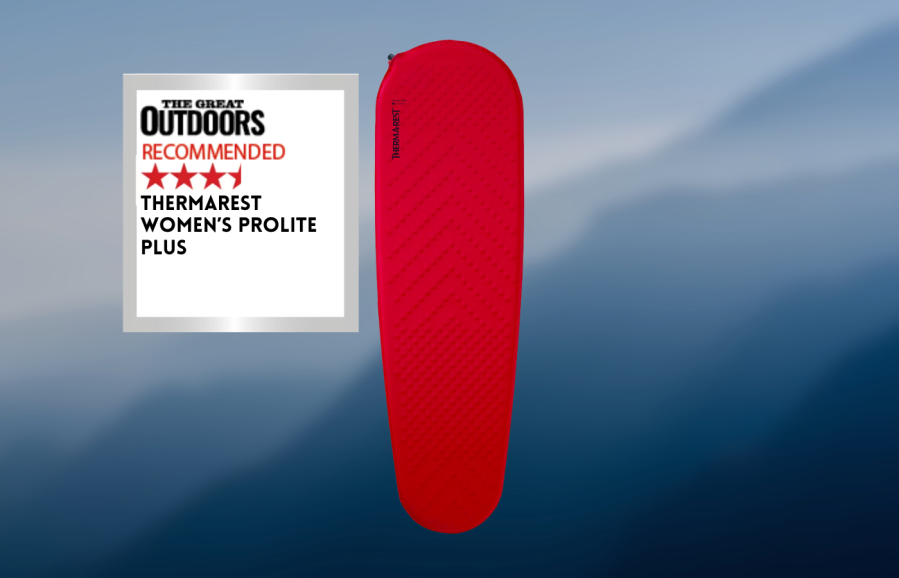
Kirsty Pallas Recommends
Overall, this is a good model if you’re happy to carry something a bit bigger and are looking for a lower price tag. It’s a great compromise between the full air mats and the only foam mats.- Warmth
- Price
- Packed size
- Thickness
| Quick specs | |
|---|---|
| Price: £130 Weight: 695g Type: Self inflating foam Materials: 50D mini hex rip polyester, urethane foam Dimensions: 168cm x 51cm Thickness: 3.8cm Rating: 3.9 R-value Sizes: Regular Men’s version: Yes URL: https://www.thermarest.com/ie |
Thermarest’s ProLite Plus sleeping mats are lightweight and comfortable, with a Women’s model that is shorter and warmer than the standard model. The R-value of this mat is 3.9, making it suitable for smaller and cooler sleepers. Self-inflating allows for easy opening and closing of the valve, maximizing airflow and making deflating and getting the air out easy. The winglock valve is large and one-way, making it easy to deflate. The mat is slightly mummy-shaped, providing a comfortable night’s sleep. However, side sleepers may feel pressure on their shoulder and hips on hard surfaces, which is less noticeable on softer ground or with additional padding.
The ProLite Plus’s pack size is the largest in this test, but it still provides insulation if punctured, unlike full air mats. It is a good compromise between full air mats and foam mats, offering a larger size and better comfort. It is a great compromise between full air mats and foam mats, offering a better fit for those looking for a lower price.
Read Kirsty’s full Thermarest, Women’s ProLite Plus Review
Nemo Tensor Extreme
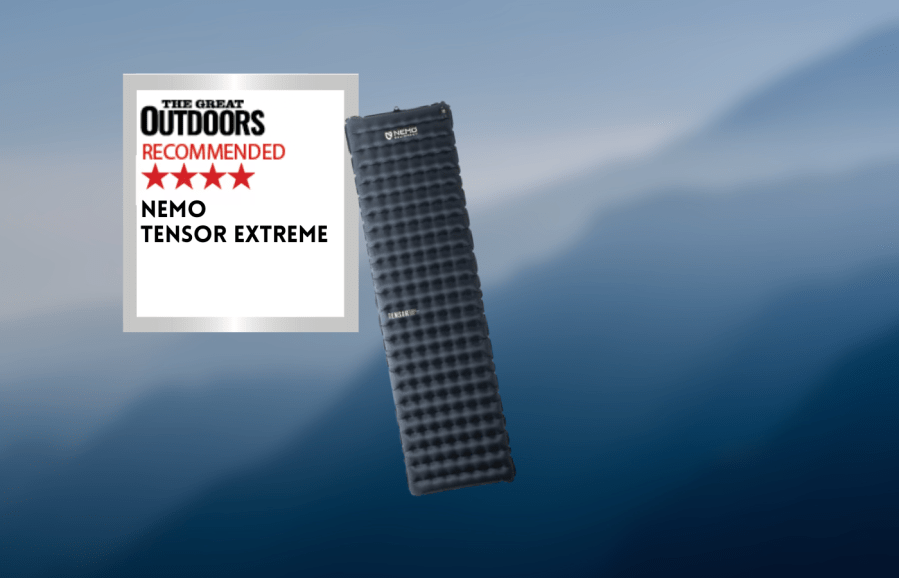
David Lintern Recommends
Overall, it’s a durable and comfortable option very cold conditions, but it may be overkill for most of the year.- Comfort
- Warmth
- Weight
- Cost
| Quick specs | |
|---|---|
| Price: £249.50 (same in dollars) Weight: 755g (Regular wide) Type: inflatable air mat Materials: 20D GRS certified Nylon, Bluesign Approved, aluminised film insulation Dimensions: 183x64cm Thickness: 9cm Rating: 8.5 Sizes: Regular, Regular mummy, long wide, regular wide Women’s version: unisex www.nemoequipment.com |
The Tensor Extreme sleeping mat, marketed as the warmest and most insulating pad on the market, is a thick air mat with a grid-based baffle structure and four layers of heat mirroring foil inside. It provides a comfortable, stable surface and is quiet when moving or turning over. Inflation is via a supplied bag, which prevents condensation buildup and improves durability. The bag is high quality, with a rubberized seal at the folding end and a nozzle that interfaces with the 2-way valve without popping off. The mat is easy to fold away and compact when packed, and weighs ¾ of a kilo. The Tensor Extreme was tested during the coldest nights of the 2023 winter season, with ground temperatures around -14C and -2C, respectively. While it is durable and comfortable in cold conditions, it may be overkill for most of the year. A repair kit is included, but a reserve mat is needed for colder conditions or in case of complete failure
Read David Lintern’s full Nemo Tensor Extreme Review
Sea to Summit, Women’s Etherlight XT Insulated
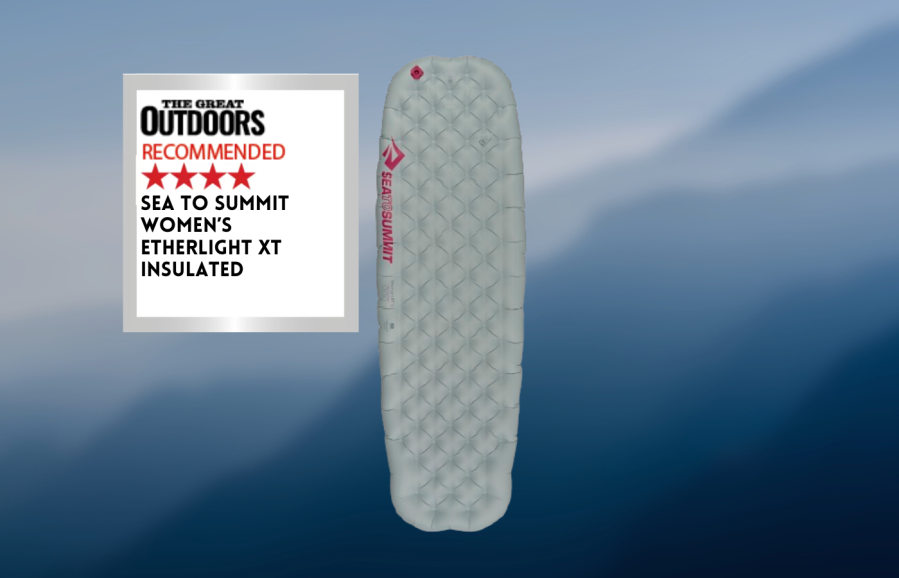
Kirsty Pallas Recommends
This mat is a very light and comfortable model, but while it has a low R-value in this test, it’s still a great option for three season camping.- Weight
- Comfort
- Low R-Value
- Pump sack shape
| Quick specs | |
|---|---|
| Price: £180 Weight: 550g Pros: Weight, comfort Cons: Lowest R-value, pump sack shape Type: Air Materials: 30D/40D nylon with TPU lamination Dimensions: 168cm x 55cm for regular Thickness: 10cm Rating: 3.5 R-value Sizes: Regular and large Men’s version: Yes, but lower R-value URL: https://seatosummit.co.uk |
Sea to Summit offers a women’s sleeping mat called the Etherlight XT Insulated, which is warmer and more comfortable than the unisex model. The mat is rectangular, narrower at the shoulders and wider at the hips and knees, making side and front sleeping more comfortable. It features air sprung cells for support and better body conformation than baffle constructions. The mat is thickest in the test, providing a close feeling to a bed.
The pump sack is built into the stuff sack and attaches to a multifunctional valve for inflating. However, the narrower stuff sack makes it difficult to inflate in a one-person tent. The mat comes with a repair kit and a pillow lock system for Sea to Summit pillows. The nylon is light and quiet, and it has an internal antimicrobial treatment to prevent mold growth.
Despite its low R-value, the Etherlight XT Insulated mat is a lightweight and comfortable option for three-season camping. It can be easily packed into a rucksack and is not rigid at 28cmx12cm. Overall, the Etherlight XT Insulated mat is a great choice for women’s sleeping mats.
Read Kirsty’s full Sea to Summit, Women’s Etherlight XT Insulated Review
Big Agnes, Divide Insulated
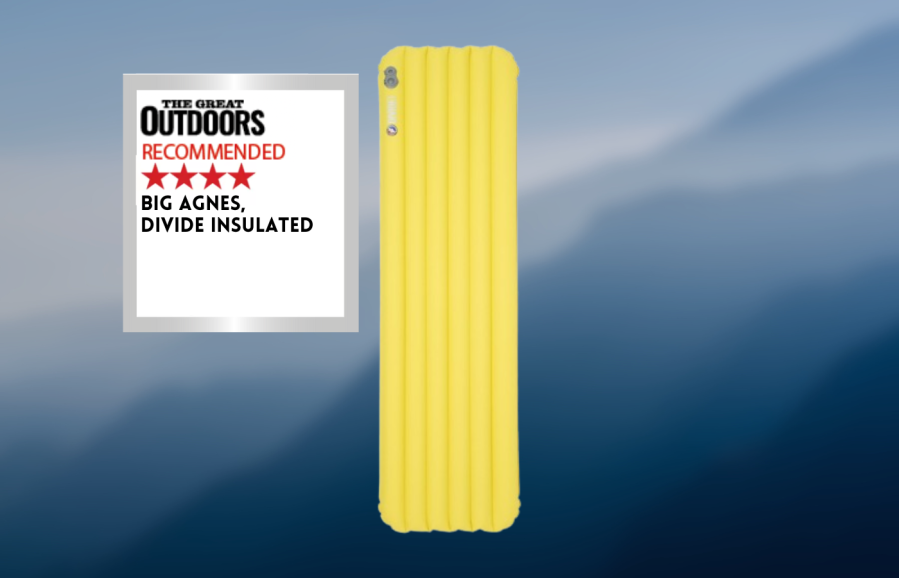
Kirsty Pallas Recommends
It’s a heavy air mat, however I think it’s a worthy compromise for the warmth when it comes in at a lower price tag than the other models.- Price
- Comfort
- Weight
- Valve position
| Quick specs | |
|---|---|
| Price: $119.95/£92 Weight: 693g Type: Air Materials: Recycled nylon ripstop, Thermolite insulation, TPU lamination Dimensions: 168cm x 51cm for petite Thickness: 9cm Rating: 4.0 R-value Sizes: Petite, regular, regular wide, wide long, and double Men’s version: Unisex URL: https://www.bigagnes.com |
Big Agnes’ Divide Insulated sleeping mat is a high-quality, affordable option for camping. It has a higher R-value, making it suitable for three-season camping and winter nights when combined with a foam mat. The insulation is provided by a built-in heat-reflecting film throughout the mat. The mat features vertical baffles that run the full length, creating a rectangular shape and providing comfort. The mat comes with a pump sack for easy pumping and a one-way valve for inflating and deflating.
A small repair kit is also included. The outer material is recycled nylon ripstop, making it durable and tough. The mat has an internal antimicrobial treatment to prevent mold buildup. The Divide Insulated packs down to 23cmx12cm but is the heaviest of the air mats, but it’s a worthy compromise for warmth at a lower price. The mat comes with a pump sack, a one-way valve, and a small repair kit.
Rab Stratosphere 5.5

SQUIRREL_BUTTON_12925513
- Pros: Warmth, comfort
- Cons: Weight
- RRP: $140 | £120
- Available from Amazon
- Weight: 816g
- Rating: 4.5/5
Type: air | Materials: 75D Recycled Polyester, Stratus R 100% recycled polyester 250gsm insulation | Dimensions: 183x51cm (R) | Thickness: 8cm | Sizes: Regular + Long/Wide (1060g, 196x64cm) | Rating: R-value 5.5
The Stratosphere has the highest R-value in our guide to the best sleeping mats, making it an excellent sleeping platform. It is a narrow mat with enlarged outer lengthwise baffles that help keep the user centred. It has thick synthetic fill that insulates well from the ground, but does add to bulk. A basic puncture repair patch and an inflation pump sack are included, making it a great-value and well-designed sleeping pad year-round choice for wild camping and multi-day trips.
Read more: Rab Stratosphere 5.5 review
Available from: rab.equipment
Alpkit Cloud Base
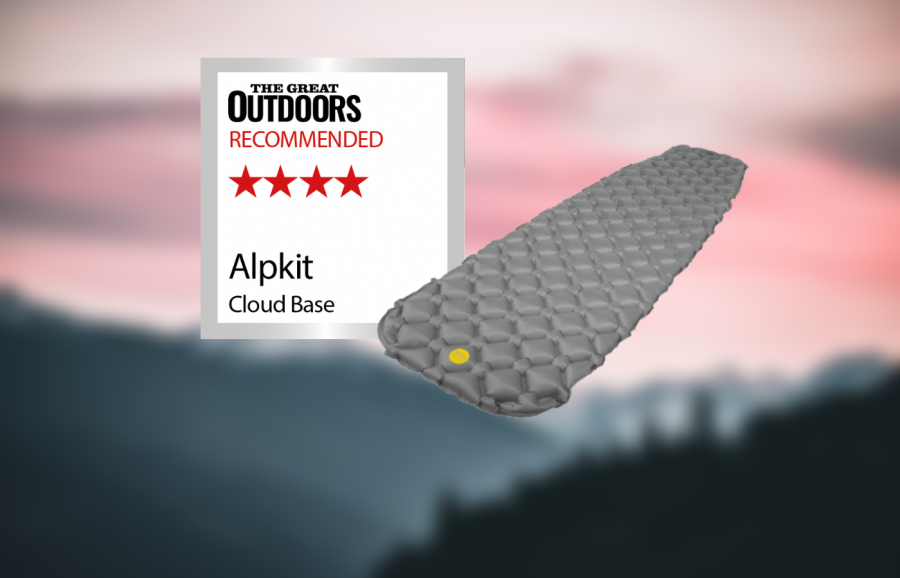
- Pros: Weight and packability, price
- Cons: Low R-value
- RRP: $64.99 | £50
- Weight: 506g
- Rating: 4/5
Type: air | Materials: 20D nylon with TPU laminate | Dimensions: 189x56cm | Thickness: 5cm | Sizes: one size | Rating: R-value 1.4
The Cloud Base sleeping pad has a different construction to the other models in our test of the best sleeping mats, consisting of a matrix of air pockets in two different sizes. This gives it a distinctive texture and helps to keep feet from slipping off the tapered end of the mat. On rough ground, it does bed down well and inflation and deflation are simple. It packs down to 28x8cm in its stuffsack and comes with a puncture repair kit. Its low R-value makes it a fair-weather-only choice, but its relatively modest weight and robust fabric make it an excellent choice for wild camps in the summer hills.
Read more: Alpkit Cloud Base review
Available from: alpkit.com
Exped Ultra 3R M Mummy
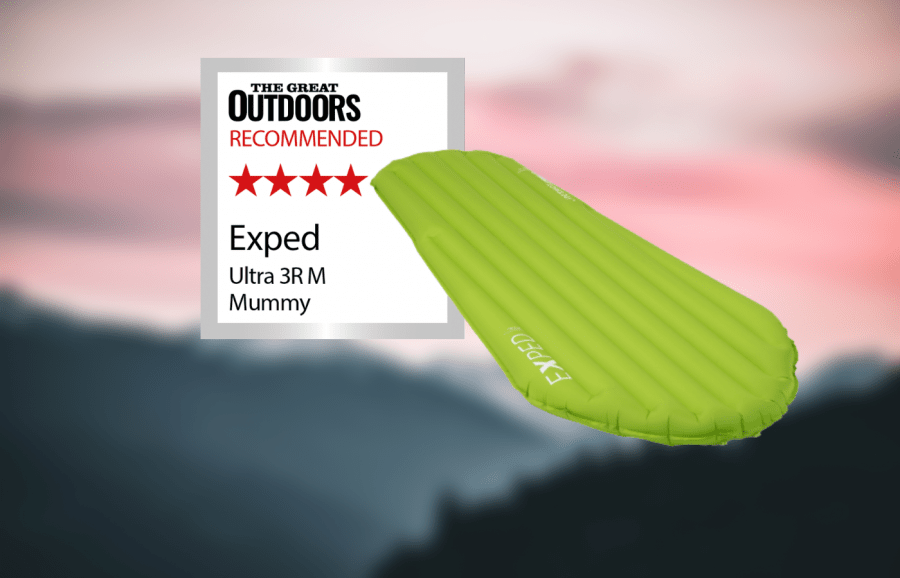
SQUIRREL_BUTTON_12925676
- Pros: Weight and packability
- Cons: Very tapered foot
- RRP: $159.99 | £150
- Available from Alpine Trek
- Weight: 360g
- Rating: 4/5
Type: air | Materials: 20D recycled ripstop polyester, 60gsm Texpedloft microfibre bluesign-certified | Dimensions: 183x52cm (M) | Thickness: 7cm | Sizes: Medium + Medium/Wide (440g, 183 x 65cm) + Long/Wide (465g, 197x65cm) | Rating: R-value 2.9
The Exped Ultra is the lightest sleeping pad in our guide to the best sleeping mats and it packs down to 21x10cm in its supplied stuffsack, making it a good choice for high camps or multi-day trips. It is comfortable and thick with a smooth surface, and is warm with light microfibre insulation. Despite its low weight, the fabric feels tough and there is a supplied repair kit. Inflation and deflation of the longitudinal baffles is straightforward using two valves, and a separate pump bag for inflation is provided.
Read more: Exped Ultra 3R M Mummy review
Available from: exped.com
Sea To Summit Ether Light XT Insulated Mat
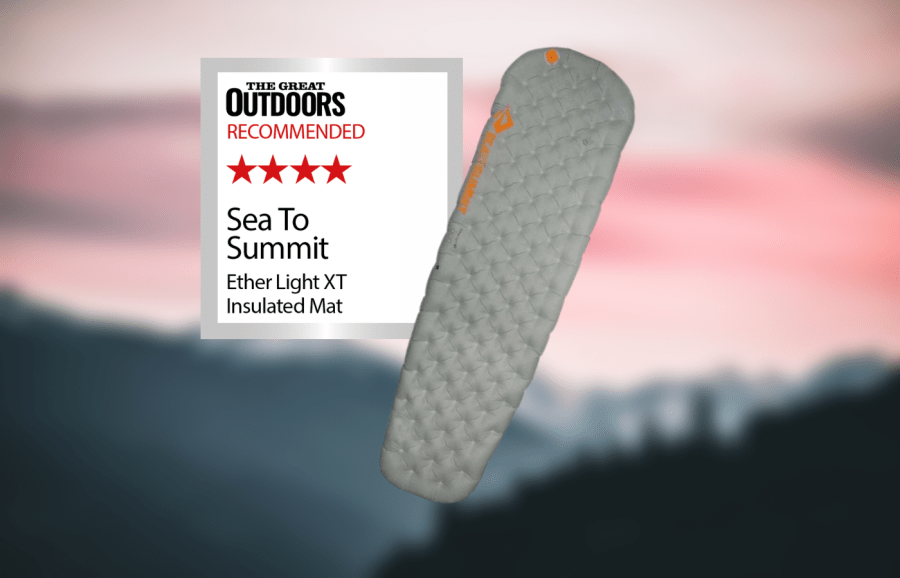
SQUIRREL_BUTTON_12925677
- Pros: Weight, warmth
- Cons: Price
- RRP: $219 | £170
- Available from Alpine Trek
- Weight: 464g
- Rating: 4/5
Type: air | Materials: 30/40D nylon, Thermolite insulation | Dimensions: 183x55cm (R) | Thickness: 8cm | Sizes: Small (400g, 168x55cm) + Regular + Large (560g, 198x64cm) | Rating: R-value 3.2
The Ether Light is a thick, gently rounded mummy shape with Thermolite insulation, an R-rating of 3.2, and a pack size of 23x12cm with the supplied stuffsack. A repair kit includes a variety of patches and a pillow attachment system. The quality and performance of the Ether Light is high, with a price to match.
Read more: Sea To Summit Ether Light XT Insulated Mat review
Available from: seatosummit.co.uk
Therm-a-Rest NeoAir XLite NXT

SQUIRREL_BUTTON_12925678
- Pros: Weight, packability, warmth
- Cons: Price
- RRP: $209.95 | £210
- Available from Amazon
- Weight: 378g
- Rating: 4/5
Type: air | Materials: 30D rip HT nylon, polyurethane | Dimensions: 183x51cm (R) | Thickness: 7cm | Sizes: Short (330g, 168x51cm) + Regular + Regular Wide (440g, 183x64cm) + Regular Long (470g, 196x64cm) | Rating: R-value 4.5
This mat gained the top spot in The Great Outdoors Awards for 2023, with the jury recognising it for its Thermacapture lining, a heat reflecting layer within the mat that ups its R-value to an impressive 4.5. The previous version of this mat had a reflective lining, but this was rustly and made for a noisy sleep. With this new version, Therm-a-rest have got rid of that issue and upped the insulating value without adding any extra weight,
“The ThermaCapture material within the previous mat would rustle whenever you moved,” said Will Renwick. “That problem doesn’t exist any more. It offers an extremely comfortable, warm and a quiet night’s sleep now.”
The NeoAir is a compact, rounded mummy shape and a small pack size of 20x13cm. It is easy to inflate with the pump sack that comes with it and has a repair kit with cleaning wipes and stick-on patches. Performance and low weight make it an excellent choice for high camps and multi-day trips, but it does come at a premium price.
Read more: Therm-a-Rest NeoAir Xlite NXT review
Available from: thermarest.com
Nemo Quasar 3D Insulated Long Wide
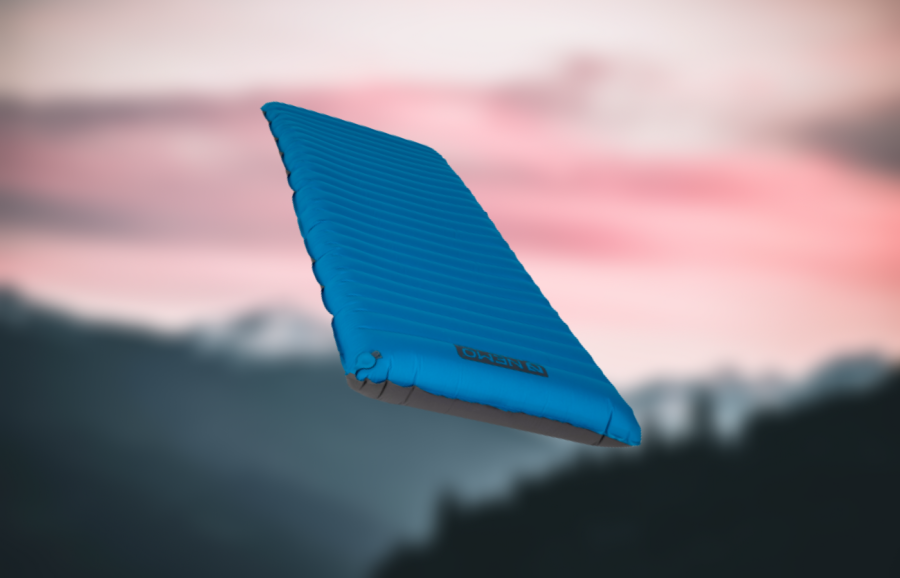
SQUIRREL_BUTTON_12925679
- Pros: Comfort, warmth
- Cons: Weight
- RRP: $199.95 | £200
- Available from Nemo Equipment
- Weight: 944g
- Rating: 3/5
Type: air | Materials: 30D 100% PCR PU polyester ripstop, bluesign-certified, PrimaLoft 100% PCR | Dimensions: 193x64cm (L/W) | Thickness: 9cm | Sizes: Regular (790g, 183x51cm) + Regular Wide (930g, 183x64cm) + Long Wide | Rating: R-value 3.3
The Quasar sleeping pad is a comfortable and secure sleeping mat, but it is heavy and the large stuffsack pack size makes it best suited to lower-level camps. Thick, 9cm deep side-to-side baffles and the large footprint result in a squishy mattress and the potential to feel the ground when sitting or lying on one’s side. The R-value is high at 3.3 with Primaloft recycled insulation for cold-night comfort, and the included repair kit is faff-free.
Read more: Nemo Quasar 3D Insulated Long Wide review
Available from: nemoequipment.com
Therm-a-rest Prolite Plus Short
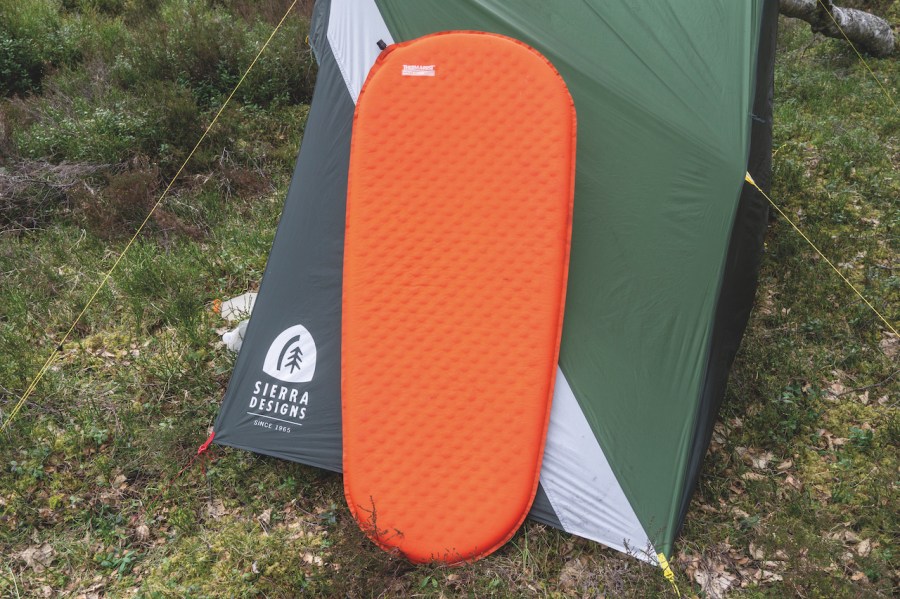
- Pros: lightweight, compact, comfortable, warm, durable
- Cons: nothing
- RRP: $105 | £110
- Available from Alpine Trek
- Weight: 0.99 lb | 450g
- Rating: 5/5
Type: self-inflating | Materials: polyester shell, diagonal-cut foam inner | Dimensions: 119 x 51cm | Thickness: 3.8cm | R-value: 3.2
This lightweight sleeping mat has been used extensively by our gear editor Chris Townsend who gave it a gold star 5 out of 5 review. “This is the best mat reviewed for warmth, weight and cost,” says Chris. “It’s suitable for year round use – I’ve slept on snow and frozen ground and felt no ground cold coming through.”
It’s a short mat that’s designed for those minimalists who, for the sake of keeping their pack weight low, are happy to forgo any padding or insulation from the knees down. In mild to warm conditions when the ground temperature isn’t low, many backpackers will find this will be more than adequate for a good night’s sleep. That’s said, those who like a bed-like luxuriously soft and cosy night’s sleep might want to look elsewhere.
This mat uses an open cell foam insulation structure, so it sits in the middle between fully inflatable sleeping mats and classic closed cell foam mats. This means it doesn’t have the bouncy, lilo-like feel of an air mat but also has the slightly chunkier packed size of a closed cell foam mat.
It’s fully self-inflating. All you need to do is open up its valve and it’ll do all the hard work itself – though it will usually require a puff or two just to get it up to pressure. It’s also, from our experience, quite durable too. That’s thanks to its high denier fabrics which are designed to withstand a bit of abrasion.
More info: thermarest.com
Lomo Folding Camping Mat
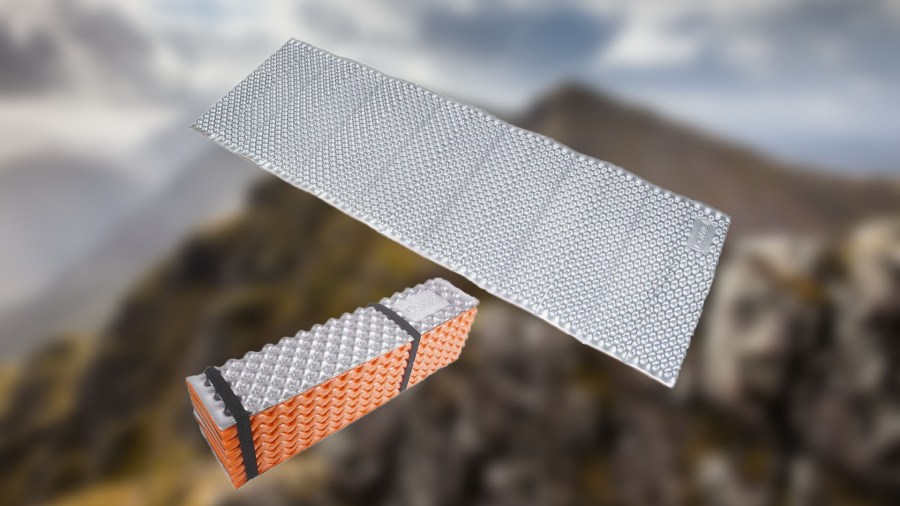
SQUIRREL_BUTTON_12925682
- Pros: tough, can’t deflate, low cost
- Cons: bulky, not that comfortable
- RRP: £20
- Available from Lomo
- Weight: 0.90 lb | 410g
- Rating: 4/5
Materials: closed-cell cross-linked polyethylene (XPE) foam | Dimensions: 180 x 57cm | Thickness: 2cm | R-value: 2.0
This comes recommended by TGO gear editor Chris Townsend who awarded it four out of five stars following his tests. It’s a mat that can be used by itself during summer camps and then, come winter, it’ll serve excellently as that extra layer of insulation underneath an inflatable sleeping mat. Made from closed cell cross-linked polyethylene foam, this type of sleeping mat is lightweight and quite small in packed size and, perhaps more importantly, it’s also very durable and reliable, being capable of withstanding the kind of punctures and abrasions that would condemn an inflatable mat.
The reason it’s shiny, by the way, is because it has a heat reflective coat and it also has little eggbox-like idents to trap insulation. The R-value is therefore a respectable 2.0.
This costs substantially less than most inflated options out there, making it a great value option for casual campers.
Available at: lomo.co.uk
Features to look for in a sleeping mat
Type
There’s three main types of mats, which all come in at different weights, warmths, and comforts. Starting with the simplest, plain foam mats that either fold or roll up, are very light, cheap and fairly warm but bulky to carry. Next are self-inflating mats, which are foam inside an airtight outer. They pack smaller than foam mats, and give a bit more warmth and comfort, but are still a big pack size. The final type are air filled, and inflated usually with a pump sack. They’re the smallest pack size, light, and give the comfiest night’s sleep.
R-value and shape
The R-value is a standardised measure of resistance to heat loss. When applied to sleep mats the R-value indicates how well the mat will insulate us from the ground temperature. A low value around 1 might be adequate on summer camps, whilst a value of 4 or above will help to insulate against frozen ground.
Typically, sleeping pads come in two shapes. Rectangular mats offer improved comfort and allow us to move around in our sleep with less chance of touching the ground, but they take up more floor space and will weigh more. Mummy mats taper towards our feet and work well in smaller one-person tents, but feet can slip off more easily whilst asleep.
Construction
Air filled mats have baffles or cells that will affect the feeling and comfort of sleeping on them. Baffles run either horizontally or vertically along the mat, with horizontal baffles letting the mat accommodate lumpy ground, and vertical baffles give a flatter sleeping surface. Vertical baffles also often have a ‘bathtub’ feature with higher baffles on the side to stop you rolling out. The other construction type is cells, which feel more like a mattress than the classic baffles.
Weight
If we’re based at a low-level campsite and walking the hills with a return to camp for bed, a larger and heavier mat will likely be fine. If we’re carrying our overnight gear across the hills, a lighter mat will be very welcome. There is always a balance to be struck between weight and performance, depending on our plans.
Inflation
Self-inflating mats have compressed foam inside that expands when the air valve is opened. All the mats in this review must be inflated manually. All can be inflated by blowing into an air valve on the mat itself, but some models come with extra sacks that can be used as bellows to inflate the mat.
These can prolong the life of the mat by reducing moisture inside (from one’s breath), but can be fiddly and time-consuming, especially in restricted tent space. It’s worth noting that mats don’t have to be fully inflated, and that you can adjust for your own comfort level.
Variety
Some products can still be found in a women’s-specific format, with differing levels of insulation and different sizing. Current models come in different lengths and widths so you can pick one that best suits your body shape.
Women’s models
These are often shorter and have a higher R-value as women sleep a bit cooler, so there’s more insulation in these.
Fabric and construction
The fabric used must be supple and durable enough for multiple inflation and storage cycles. It must be puncture-resistant to prevent a night on cold or stony ground. Look for puncture repairs kits included with your mat, or take your own on camps.
Construction types vary greatly from simple sheets of foam to down-filled mats for sleeping on snow. Here we’ve concentrated on a middle range, useable in varied conditions (outside the true depths of winter). Fabric and manufacturing technology have advanced greatly, meaning that modern mats can achieve a relatively high R-value without incurring a weight penalty.
Sleeping mat construction: a guide to the different types
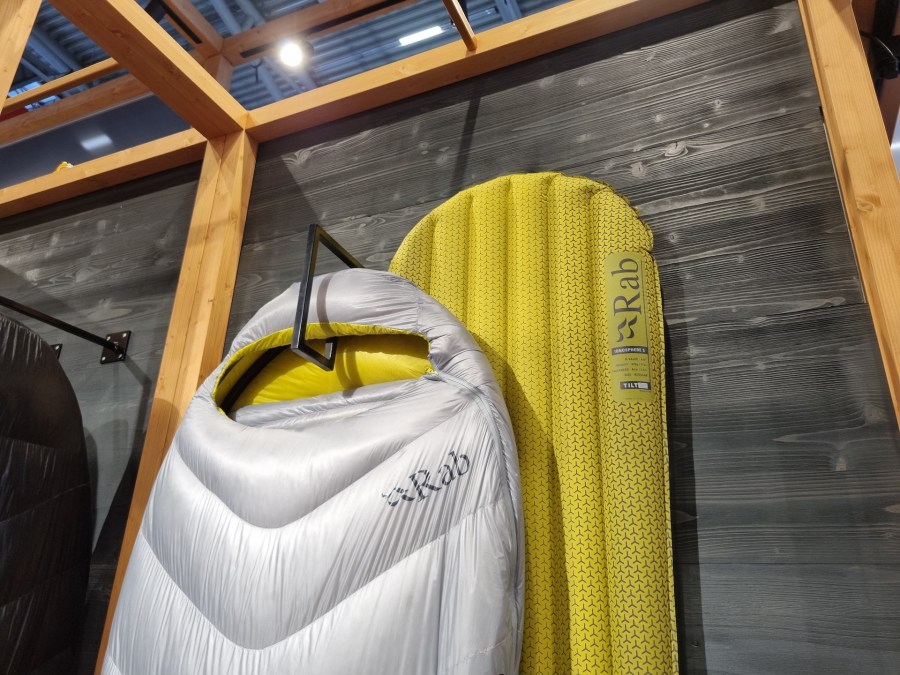
While all sleeping mats might be designed with the same end goal in mind – providing a comfortable night’s sleep – there’s a surprisingly amount of variation in how some sleeping mats are constructed in comparison to each other. Some are very simple and just involve a sheet of foam, others are more complex, involving closed cell foam or interlinked air chambers. Here are some of the options and their advantages and disadvantages. 25
Foam Mats
Foam mats are a classic and reliable option for lightweight camping. Constructed from closed-cell foam, these mats provide a degree of comfort and insulation. The solid foam construction makes them highly durable and resistant to punctures, making them suitable for rough use and rocky terrains. They are among the lightest sleeping mat options available, making them ideal for ultralight backpackers. Foam mats offer decent insulation, making them suitable for three-season camping. Additionally, they come in various shapes, including rectangular, tapered, and mummy-shaped, catering to different preferences and body types. Foam mats are often used in winter as an extra layer of insulation underneath an inflatable mat.
Self-Inflating Mats
Self-inflating mats are a popular choice among campers due to the amount of comfort they can provide. These mats are designed with a combination of open-cell foam and an air valve that allows the mat to inflate partially on its own. The foam core provides cushioning and insulation, while the air valve allows air to enter, expanding the mat to a certain degree. To achieve the desired firmness, you may need to add a few breaths. Self-inflating mats offer good insulation, making them suitable for three-season camping and colder conditions. The combination of foam and air creates a comfortable sleeping surface that balances support and cushioning.
Inflatable Mats
Inflatable mats, also known as air mats, rely on air for cushioning and support. These mats are designed to be lightweight and packable, making them a popular choice for backpackers. They have one or multiple air chambers that you manually inflate with a pump or your breath. The materials used in inflatable mats, such as nylon or polyester with TPU coatings, provide both durability and comfort. Inflatable mats offer excellent cushioning and can be adjusted for firmness to suit individual preferences. When deflated, they can be compacted into a small size, making them easy to carry in your backpack. The level of insulation in inflatable mats varies, and some models are designed for specific temperature ranges or seasons. Additionally, inflatable mats come in different shapes, including rectangular, tapered, and mummy-shaped, offering options for various sleeping styles and space preferences. The main risk with these types of mats is that they can quickly become unusable if even just a slight puncture occurs and, due to that risk, it’s a good idea to carry a puncture repair kit with you.
Baffle Designs
Apart from the type of sleeping mat, the baffle design also plays a significant role in comfort and performance. Baffles are the internal compartments that hold the air or foam within the mat. Different baffle designs include horizontal and vertical baffles. Horizontal tubes run across the width of the mat, providing even support but with a risk of some shifting of air or foam during the night. Vertical tubes run the length of the mat, offering more stability and preventing air or foam from shifting as much during sleep. In addition to baffle designs, you’ll find tapered mats, which are narrower at the feet and wider at the shoulders. These mats save weight and space while still providing sufficient support and comfort. On the other hand, rectangular mats offer ample space and freedom of movement, making them suitable for those who prefer sleeping in various positions.
Understanding the different types of lightweight sleeping mat constructions and baffle designs will help you select the most suitable option for your camping needs. Consider factors such as insulation, comfort, packability, and shape to ensure a restful and enjoyable night’s sleep during your outdoor adventures. Happy camping!








